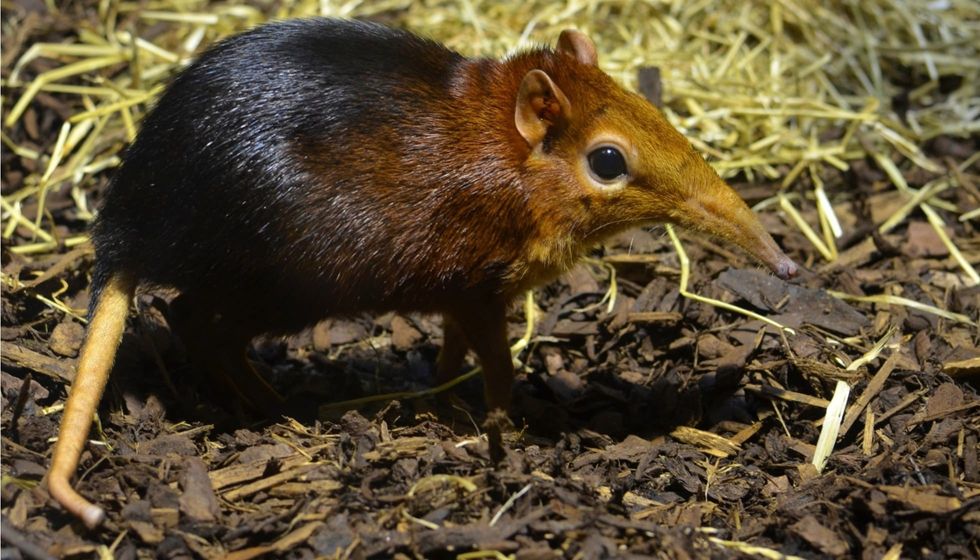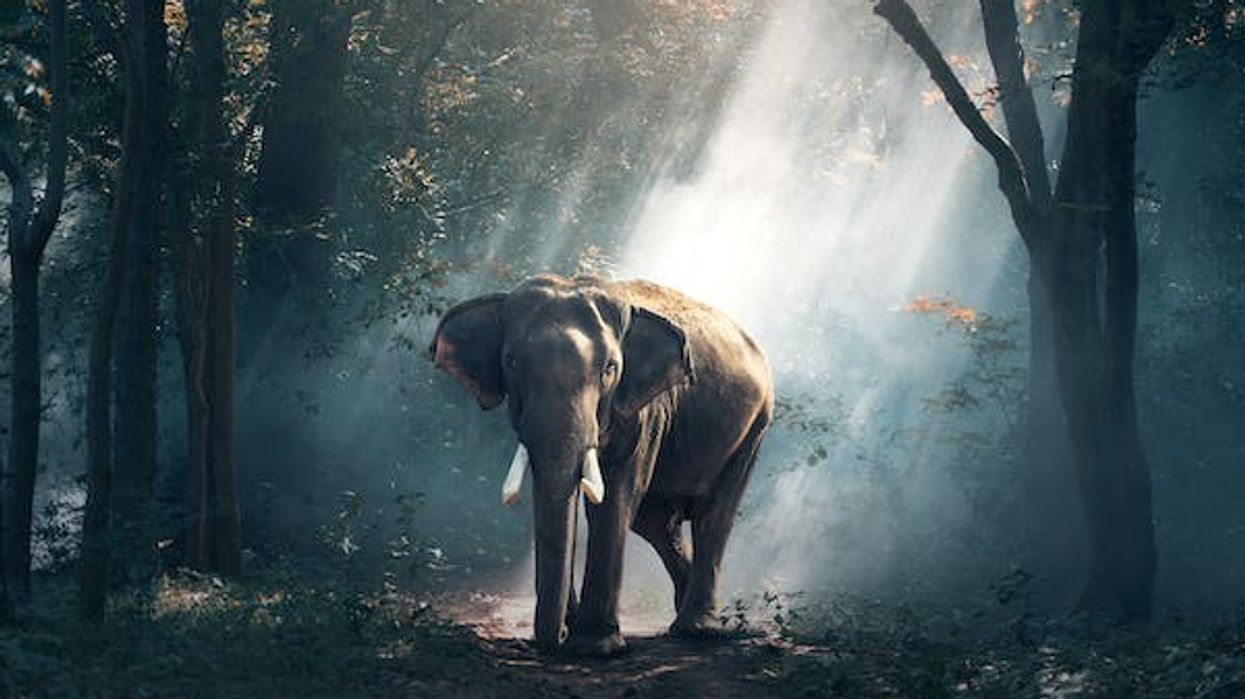Elephant shrews (also known as sengis) are classified into a single family, the Macroscelididae, which has four genera and 19 extant species. Their name comes from their tall, pointed head and very long, movable, trunk-like snout.
They have quite long legs for their size and move in a hopping motion similar to rabbits. They spend most of the day foraging and collecting leaf litter for nests. In the wild, each elephant shrew can build six or seven nests in its home range, where it sleeps, cares for its young, and avoids predators.
The IUCN Red List classifies this species as Least Concern now, earlier it was vulnerable. Explore the similar black rat and field vole facts on Kidadl.
Black and Rufous Elephant Shrew Interesting Facts
What type of animal is a black and rufous elephant shrew?
Despite the fact that black and rufous sengi has physical traits that are comparable to those of a rat or opossum, they are not classified as rodents. They are sengis of genus Rhynchocyon, which have evolved to be more closely related to elephants.
What class of animal does a black and rufous elephant shrew belong to?
Black and rufous elephant shrew (Rhynchocyon petersi) also known as black and rufous sengi is a mammal endemic to Kenya and Tanzania's lowland montane and thick forests.
How many black and rufous elephant shrews are there in the world?
The exact population range of black and rufous elephant shrew (Rhynchocyon petersi) is not known.
Where does a black and rufous elephant shrew live?
Black and rufous elephant shrew (Rhynchocyon petersi) has its habitat in forests and dense woodlands of Kenya and Tanzania. Their habitat is rather extensive, despite the fact that their home range size has not been reported.
What is a black and rufous elephant shrew's habitat?
The rufous giant elephant shrew, like other giant elephant shrews, has its habitat in lowland forests and thick woods. They live in undisturbed woods range, where they maintain huge territories and build leaf litter nests on the ground.
Rhynchocyon petersi (rufous giant elephant shrew) is native to the central and eastern African range.
They live at elevations ranging from sea level to 7546 ft (2,300 m) and are nearly entirely found in Tanzania, in the Udzungwa Mountains. Surprisingly, there are no elephant shrew species in western Africa or the Sahara range.
Who do black and rufous elephant shrews live with?
The black and rufous elephant shrew is not a gregarious creature. They live in monogamous couples with specified territories.
Because of the absence of social engagement, the couples seldom interact with one another. They share a territory but spend very little time together. They are territorial, with males driving away other males and the female chasing out another female out of their territory.
How long does a black and rufous elephant shrew live?
Little is known about the lifetime of the black and rufous elephant shrew since it is rarely seen in the wild. Golden-rumped elephant shrew, a close cousin, can live up to five years in the wild and up to 11 years in captivity. The IUCN Red List categorized this species as vulnerable once, it is under Least Concern now.
How do they reproduce?
The only time rufous and black elephant shrew comes into touch with conspecifics is during mating. Mating occurs often in a relatively short amount of time.
Black and rufous elephant shrews, like all elephant shrews, give birth to one or two young offspring at a time; litters of three or four are extremely unusual.
There is little information known on the breeding habits of black and rufous elephant shrews; however, its near relative, golden-rumped elephant shrews, have a 42-day gestation period and a 15-day weaning period and give birth to four to five young offspring each year.
Females spend minimal time with their litter, sometimes just visiting them once a day for a brief nursing period. There is no evidence of direct parental investment in newborns.
What is their conservation status?
They are listed as Least Concern by IUCN Red List of Threatened Species.
Black and Rufous Elephant Shrew Fun Facts
What do black and rufous elephant shrews look like?
They have tiny, rounded ears and are reddish/brown and black in hue. They get their name from their long, pointed snout, which is flexible and delicate.
They have guinea pig-like bodies, long, deer-like legs, triangular ears, and a long, movable snout. The mouth is positioned close to the head, beneath the long nose.
The 'trunk' is used to push through leaves or soil in search of food such as insects, small frogs, smaller animals such as newborn rats, fruits, and vegetables. They are active throughout the day and sleep in a nest at night.

How do they communicate?
These creatures seldom communicate. Although vocalizations are uncommon, black and rufous elephant shrews may foot drum or slap their tails under tense conditions.
They scent mark their territory as well, using perianal, sternal, subcaudal, or pedal glands. Elephant shrews, both black and rufous, have keen senses of sight, sound, and smell.
The pedal smell glands of black and rufous elephant shrews are most likely utilized to indicate territory or during cursorial activity. Black and rufous elephant shrews are especially nervous prey species, spending the bulk of their time either running from predators or utilizing their excellent senses of hearing and smell to keep an eye out for predators.
How big is a black and rufous elephant shrew?
Elephant shrews, both black and rufous, are tiny animals. Their bodies are 9-12 in (22.86-30.48 cm) in length (excluding the tail). The bare, mouse-like tail measures 7-10 in (17.78-25.4 cm). To frighten predators such as big snakes, leopards, and raptors, elephant shrews beat their tails against their hindquarters.
How fast can a black and rufous elephant shrew run?
The species is one of the quickest small mammals, with speeds of 17.9 mph (28.8 kph) reported . The elephant shrew can jump like a rabbit, up to 3 ft (1 m) in the air, earning it the nickname jumping shrew. They are active throughout the day and sleep in a nest at night.
How much does a black and rufous elephant shrew weigh?
The black and rufous giant elephant shrew weight is 1-1.5 lb (453.5-680.3 g). Males and females have similar appearances.
What are the male and female names of the species?
The male and female elephant shrews do not have separate names. They are simply called male or female.
What would you call a baby black and rufous elephant shrew?
The names of black and rufous elephant shrew baby are unknown. They are solely known as infant sengis or elephant shrews.
What do they eat?
Black and rufous elephant shrew diet are insectivorous. Nonetheless, their hypsodont dentition implies that they may have had a relatively herbivorous diet in the past.
Elephant shrews, both black and rufous, consume only invertebrates, they search insects under leaf litter with their large proboscis. The majority of their diet consists of ants and termites, although black and rufous elephant shrews will consume almost anything they discover on the forest floor as long as it is tiny enough to fit in their mouth.
Elephant shrews consume beetles, termites, spiders, and ants, as well as fruits and seeds. They are fed crickets, mealworms, and dry cat food supplemented with peanut oil in captivity.
Are they dangerous?
While a shrew bite is painful, the poison is not usually fatal to people. Elephant shrews, in general, do not represent a significant threat to people.
Would they make a good pet?
Elephant shrews are not suitable as pets. Because they are timid and mate for life, they would be uninteresting as pets. Captive wild animals are illegal in several places.
In some cases, a specific permit may be required. One danger is those wild animals may transmit undiscovered illnesses.
It takes generations to domesticate a species, and the elephant shrew has never been considered. Elephant shrews, like other wild animals, have highly unique environmental, social, and dietary requirements that cannot be met by a typical cage. They are similar enough to gerbils, hamsters, and guinea pigs that you would be better off getting one of those instead.
Did you know...
A little bird named the red-capped robin-chat follows them as they hunt, eating on the shrews' leftovers.
A gland on the underside of the males' tail generates a powerful fragrance that is used to identify territories.
How did black and rufous elephant shrews get their name?
Elephant shrews acquire their popular name from their long, movable trunk-like snout that they use to investigate their surroundings. These creatures are also known by their African Bantu name, 'sengis', by biologists.
The elephant shrew, which is black and rufous, is well named. Their hindquarters and tails are glossy black, while their head and forequarters are a deep red; the word rufous means red in Latin.
Why are elephant shrews endangered?
On the 2010 IUCN Red List of Threatened Species, the elephant shrew is categorized as endangered. This is primarily due to habitat loss.
The verdant woodlands in which they reside are being destroyed for agricultural and logging purposes. Some Kenyans continue to hunt them for food, which is counterproductive to Kenya's conservation efforts. These include designating the forest as a sanctuary and prohibiting loggers, ranchers, and hunters from entering it.
As of 2012, it was believed that just 12,750 of these creatures remained. There were approximately 20,000 elephant shrews in Africa at one point.
Here at Kidadl, we have carefully created lots of interesting family-friendly animal facts for everyone to discover! For more relatable content, check out these rice rat facts and gopher facts for kids.
You can even occupy yourself at home by coloring in one of our free printable pygmy shrew coloring pages.
Main image by Joey Makalintal from Pennsylvania, USA.










